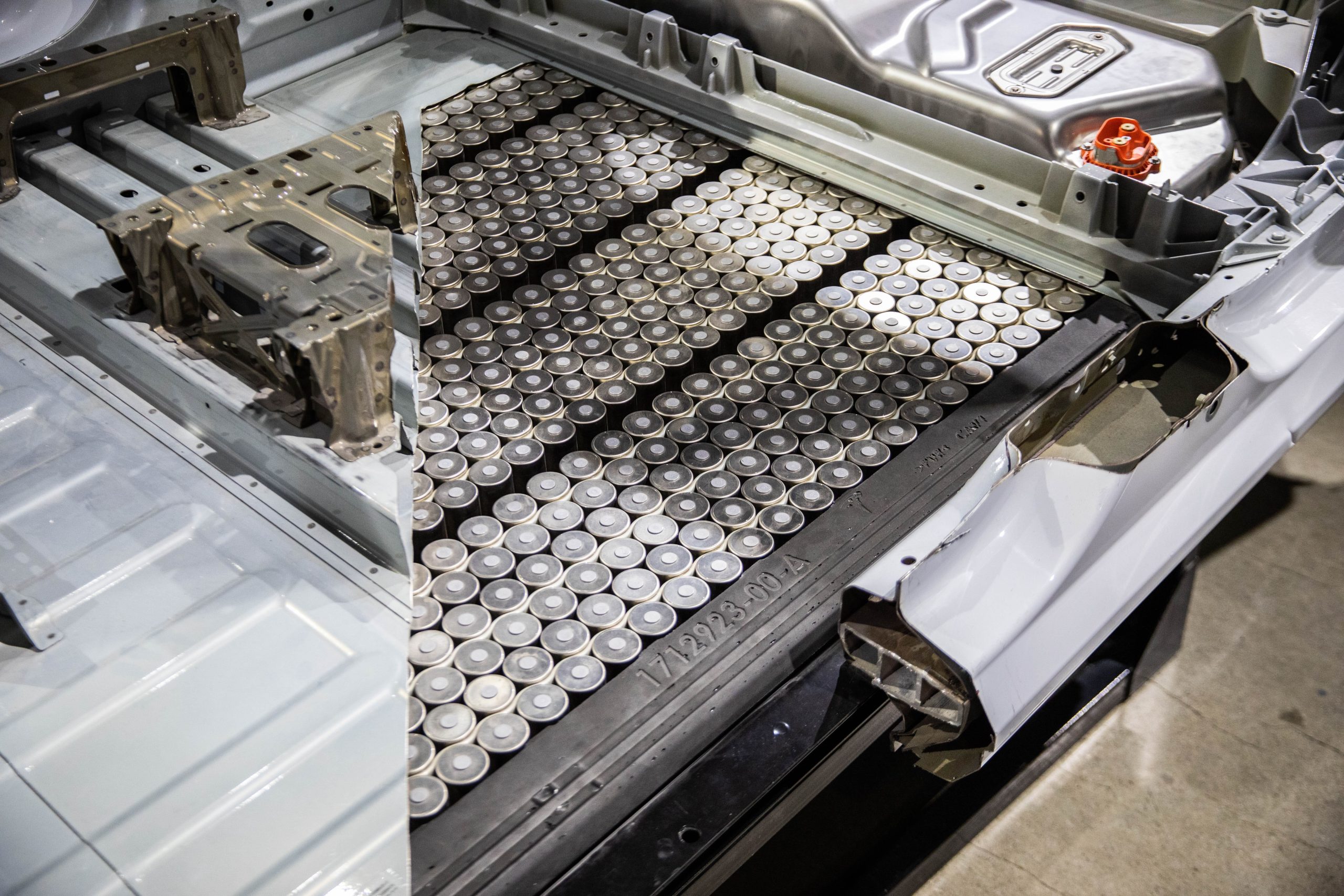
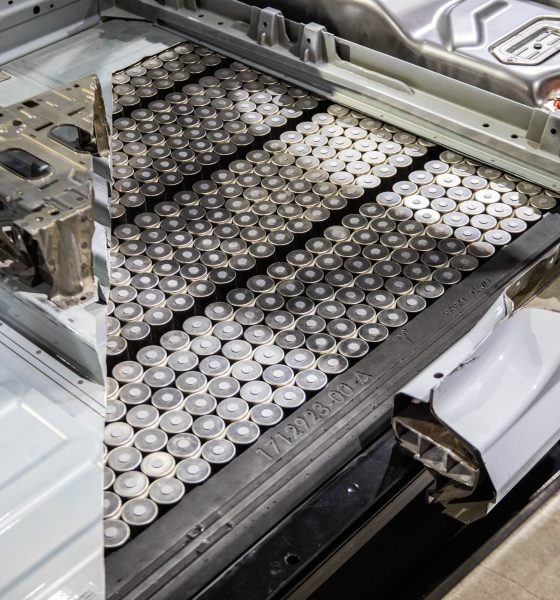
News
Tesla 4680 cells compared with BYD Blade and CATL Qilin structural batteries
The battle for the dominance of the electric vehicle sector would likely be determined by the market’s key battery makers. With this in mind, companies such as BYD, CATL, and Tesla — all of whom are exploring the structural battery form factor — have the chance to become the trailblazers of the next generation of electric car batteries.
During its Battery Day event, Tesla announced its 4680 cells, which are used alongside the company’s structural battery pack. BYD, on the other hand, has also released its Blade batteries, which also adopt a non-modular approach. CATL’s Qilin batteries are in the same segment, with its structural battery design.
Electric vehicle battery enthusiast Jordan Giesige of YouTube’s The Limiting Factor channel recently conducted a comparison of the advantages and disadvantages of Tesla, BYD, and CATL’s next-generation structural packs. Each battery pack was evaluated according to several factors, such as design, rigidity, packing and energy density, and safety, before being ranked. It should be noted that the figures used in the comparisons are drawn from estimates and materials released by Tesla, BYD, and CATL themselves, not current real-world observations.
As noted by Giesige, Tesla’s 4680 structural battery packs utilize hundreds of cylindrical cells with a cooling ribbon in between every other row of cells. A lid is then placed on top and polyurethane foam is injected into the pack. This polyurethane hardens, and the combination of the foam and the battery cells forms a rigid, honeycomb-type structure.
CATL Qilin batteries, which could be fitted with both nickel and iron-based cells, integrate thermal pads, the liquid cooling plate, and the cross bracing to create what could be described as structural cooling. The structural cooling is placed between each row of prismatic battery cells, and the cells themselves are placed into the pack directly without any modules. BYD Blade batteries use iron-based prismatic cells, though these cells are longer and thinner than those used by CATL. The cells are then stretched across the BYD Blade battery pack, allowing the cells themselves to replace conventional steel beams.
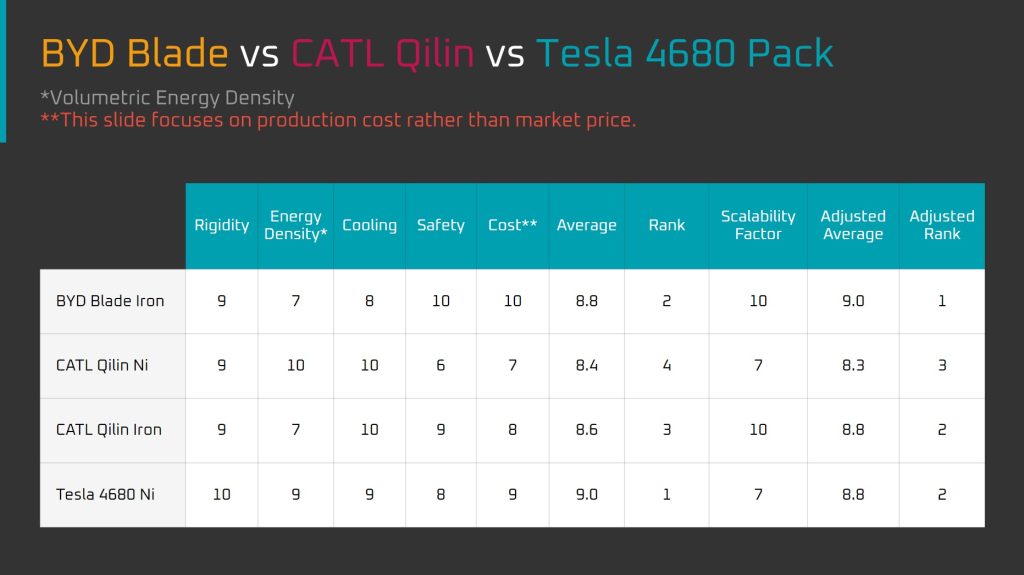
In the rankings of the next-generation batteries, the YouTube host noted that Tesla’s 4680 structural battery pack would likely be the most rigid among its peers. Tesla’s 4680 pack loses out in terms of packing density, however, as BYD and CATL’s use of prismatic cells maximizes volumetric energy density. With this in mind, and considering that CATL’s Qilin batteries can be fitted with high-energy density nickel-based cells, a nickel-based Qilin battery would likely be more energy dense than a nickel-based Tesla 4680 pack or a BYD Blade structural battery, which uses less energy dense iron-based cells.
As for cooling, Giesige noted that the BYD Blade batteries’ plate cooling would likely fall short of the Tesla 4680 pack and CATL Qilin battery’s cooling systems. In its marketing materials, CATL highlighted that cooling the sides of the Qilin battery increases the pack’s cooling area four times. Tesla’s 4680 battery also uses better cooling than BYD’s Blade batteries with its side cooling system, though it would likely not be as good as the cooling of CATL’s Qilin structural packs.
While BYD’s Blade batteries lose out in cooling, they are also likely the safest among its peers. This is because the BYD Blade battery uses iron-based cells, which have a higher decomposition and lower heat release temperature than the nickel-based cells used in Tesla’s 4680 cells and CATL’s nickel-based Qilin batteries. An iron-based Qilin battery comes second to the BYD Blade, partly due to its use of shorter and thicker prismatic cells, which may trap more heat.
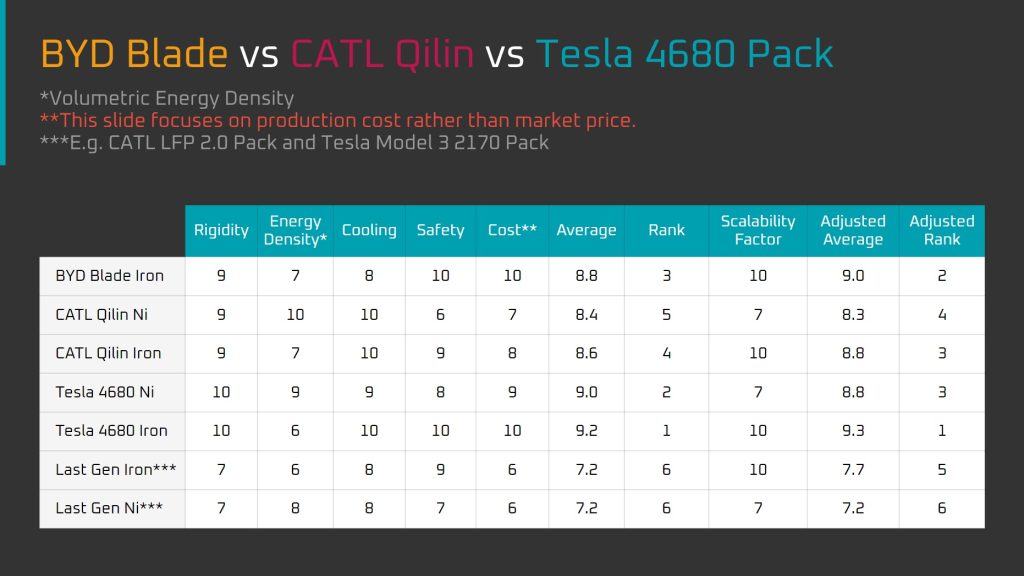

A Qilin pack with nickel-based cells was ranked last in terms of safety by the battery enthusiast, as Tesla’s 4680 pack with nickel-based cells features several safety systems, such as an overpressure mechanism on the bottom of the cells themselves. Since 4680 cells are also smaller than the prismatic cells used in the BYD Blade and CATL Qilin, they contain less energy. The 4680 cells themselves are enclosed in a thick shell as well, which are about 2-3 times thicker than a conventional battery.
Overall, Giesige noted that Tesla’s 4680 cells are likely the best all-rounder compared to its peers in the structural battery segment. The overall scores of the BYD Blade and CATL Qilin batteries bode well for Tesla’s future, however, as the companies could become suppliers of the EV maker in the future. CATL is already supplying Tesla with LFP batteries today, and BYD is heavily rumored to be a Tesla supplier as well. In a way, the analysis of the next-generation structural EV batteries shows that Tesla is not alone in pushing the battery industry forward.
Watch The Limiting Factor‘s full analysis in the video below.
Don’t hesitate to contact us with news tips. Just send a message to simon@teslarati.com to give us a heads up.

News
Tesla FSD approved for testing in Nacka, Sweden, though municipality note reveals aggravating detail
Nacka, Sweden, a municipality just a few miles from Stockholm, has given its approval for FSD tests.
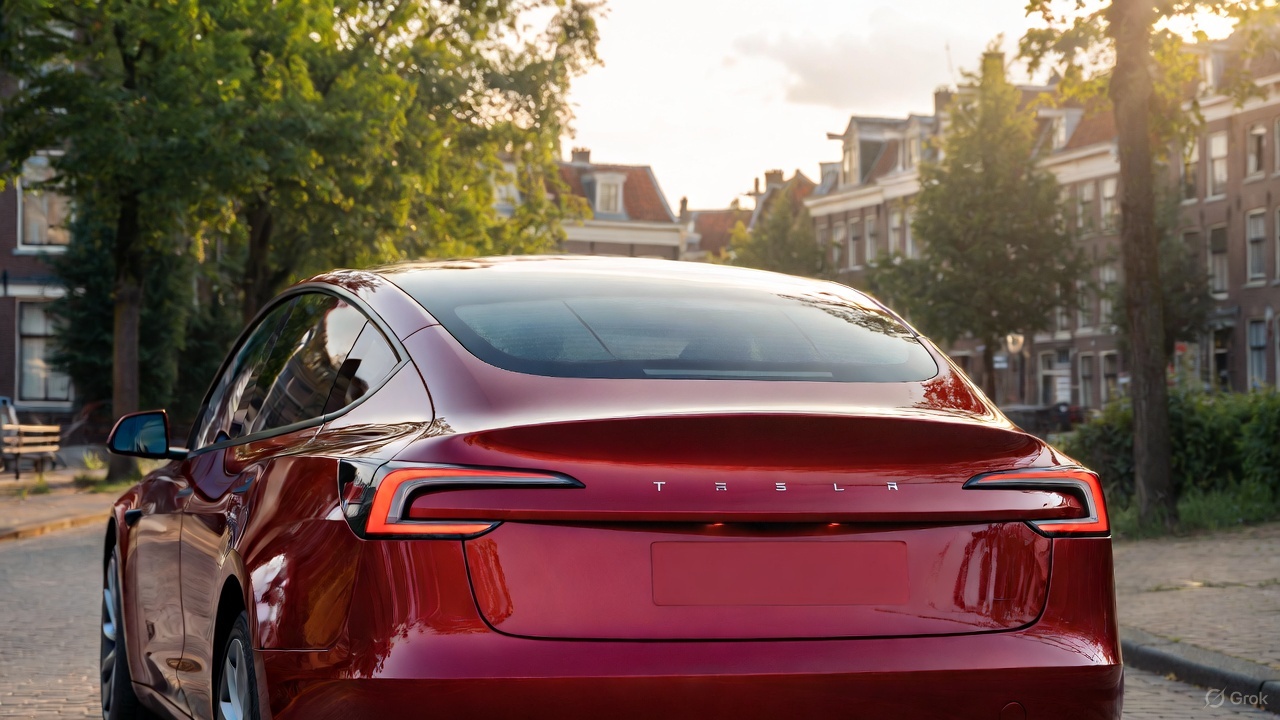
Tesla has secured approval for FSD testing in an urban environment in Sweden. As per recent reports from the Tesla community, Nacka, Sweden, a municipality just a few miles from Stockholm, has given its approval for FSD tests.
A look at the municipality’s note regarding FSD’s approval, however, reveals something quite aggravating.
FSD testing approval secured
As per Tesla watcher and longtime shareholder Alexander Kristensen, Nacka is governed by the Moderate Party. The shareholder also shared the municipality’s protocol notes regarding approval for FSD’s tests.
“It is good that Nacka can be a place for test-driving self-driving cars. This is future technology that can both facilitate mobility and make transportation cheaper and more environmentally friendly,” the note read.
The update was received positively by the Tesla community on social media, as it suggests that the electric vehicle maker is making some legitimate headway in releasing FSD into the region. Sweden has been particularly challenging as well, so securing approval in Nacka is a notable milestone for the company’s efforts.
Aggravating details
A look at the notes from Nacka shows that FSD’s proposed tests still met some opposition from some officials. But while some critics might typically point to safety issues as their reasons for rejecting FSD, those who opposed the system in Nacka openly cited Tesla’s conflict with trade union IF Metall in their arguments. Fortunately, Nacka officials ultimately decided in Tesla’s favor as the company’s issues with the country’s unions are a completely different matter.
“The left-wing opposition (S, Nackalistan, MP and V) voted no to this, referring to the fact that the applicant company Tesla is involved in a labor market conflict and does not want to sign a collective agreement. We believe that this is not an acceptable reason for the municipality to use its authority to interfere in a labor law conflict.
“Signing a collective agreement is not an obligation, and the company has not committed any crime. The municipality should contribute to technological development and progress, not work against the future,” the note read.
News
Tesla Model 3 and Model Y named top car buys in Norway
Despite growing competition from European and Korean brands, both models stood out for their balance of price, performance, and everyday usability.
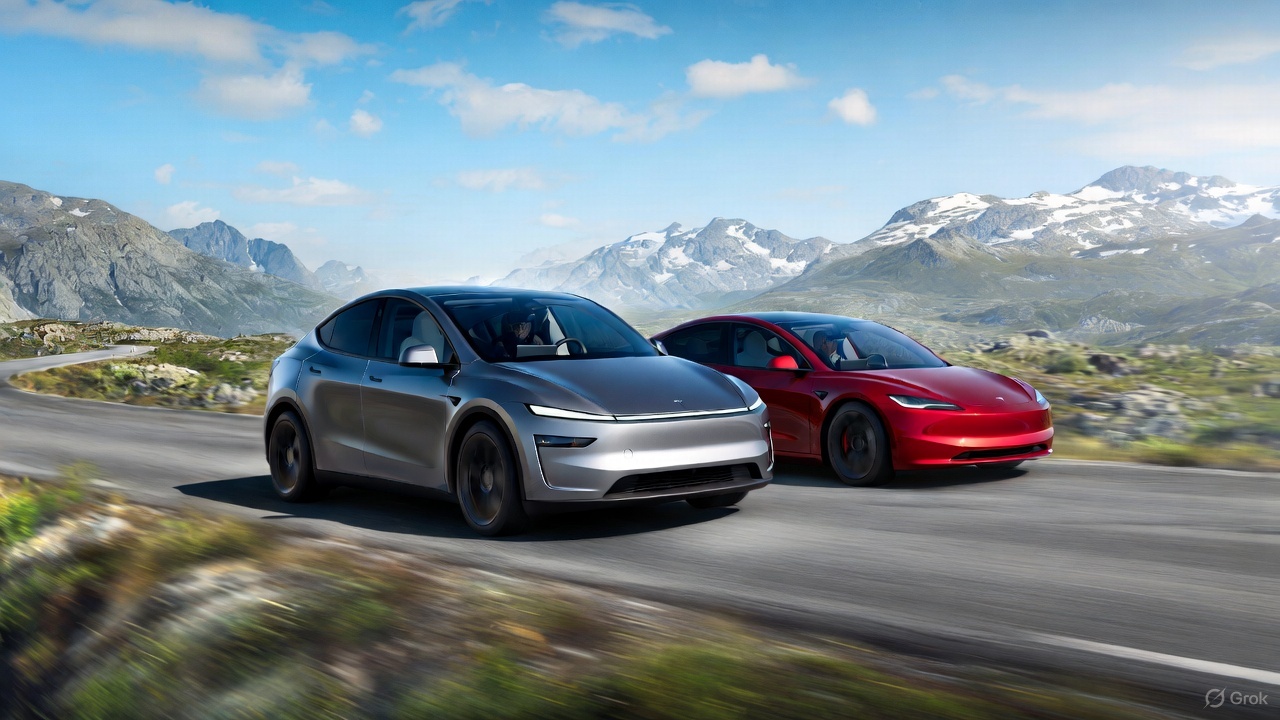
Norway’s annual roundup of the best car purchases featured Tesla’s two main sellers this year, with the Model 3 and Model Y securing top positions in their respective segments.
Despite growing competition from European and Korean brands, both models stood out for their balance of price, performance, and everyday usability. The verdict comes as electric vehicle adoption remained above 95% of new vehicle sales in the country.
Tesla Model 3 strengthens its value position
Among compact EVs, the Tesla Model 3 maintained its position as the best overall buy thanks to its strong blend of performance, efficiency, and updated features. Reviewers noted that every trim offered compelling value, especially with the all-electric sedan’s improved cabin ergonomics and the return of the turn-signal stalk, which was one of the few previous complaints among drivers.
The Model 3’s mix of long-range capability, low operating costs, and responsive handling has continued to set the benchmark for compact EVs in Norway. While competitors from Hyundai, Volkswagen, and Peugeot have narrowed the gap, Tesla’s price-to-capability ratio has remained difficult to beat in this segment, Motor.no reported.
“The Model 3 clearly offers the best value for money in the compact class, no matter which version you choose. Now it also gets the turn signal lever back. This eliminates one of the few flaws in a driving environment that many believe is the best on the market,” the publication wrote.
Tesla Model Y claims its crown
The Tesla Model Y emerged as Norway’s top family-car purchase this year. The latest refresh introduced improvements in ride quality, styling, and interior materials, allowing the Model Y to deliver a more premium driving experience without a substantial price increase.
Reviewers praised its spacious cabin, strong safety profile, and practical range, all of which reinforced its appeal for families needing an all-purpose electric crossover. The Model Y remains especially notable given its continued popularity in Norway even as Tesla faces declining sales in other global markets.
“The Model Y is back as the winner in the family class. The upgrade in the new year was even more extensive than expected. It is a slightly more elegant and significantly more comfortable Model Y that solidifies its position as Norway’s best car purchase in the most important class,” the Norwegian motoring publication noted.
News
Tesla Giga Berlin is still ramping production to meet Model Y demand: plant manager
Tesla Gigafactory Berlin has expanded to two full shifts, as per the facility’s plant manager, and a lot of it is due to Model Y demand.

Tesla Gigafactory Berlin has expanded to two full shifts, as per the facility’s plant manager, and a lot of it is due to Model Y demand. While registrations in some countries such as Sweden have fallen sharply this year, the company’s sales in other key territories have been rising.
Giga Berlin shifts to two shifts
Giga Berlin factory manager André Thierig told the DPA that the facility has been running two shifts since September to manage a surge in global orders. And due to the tariff dispute with the United States, vehicles that are produced at Giga Berlin are now being exported to Canada.
“We deliver to well over 30 markets and definitely see a positive trend there,” Thierig said.
Despite Giga Berlin now having two shifts, the facility’s production still needs to ramp up more. This is partly due to the addition of the Tesla Model Y Performance and Standard, which are also being produced in the Grunheide-based factory. Interestingly enough, Giga Berlin still only produces the Model Y, unlike other factories like Gigafactory Texas, the Fremont Factory, and Gigafactory Shanghai, which produce more than one type of vehicle.
Norway’s momentum
Norway, facing an imminent tax increase on cars, has seen a historic spike in Tesla purchases as buyers rush to secure deliveries before the change takes effect, as noted in a CarUp report. As per recent reports, Tesla has broken Norway’s all-time annual sales record this month, beating Volkswagen’s record that has stood since 2016.
What is rather remarkable is the fact that Tesla was able to achieve so much in Norway with one hand practically tied behind its back. This is because the company’s biggest sales draw, FSD, remains unavailable in the country. Fortunately, Tesla is currently hard at work attempting to get FSD approved for Europe, a notable milestone that should spur even more vehicle sales in the region.









